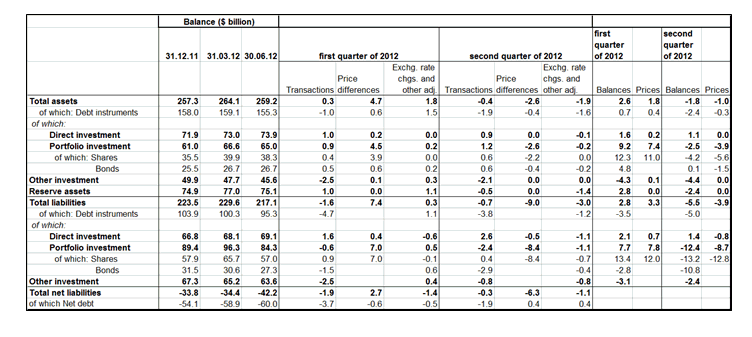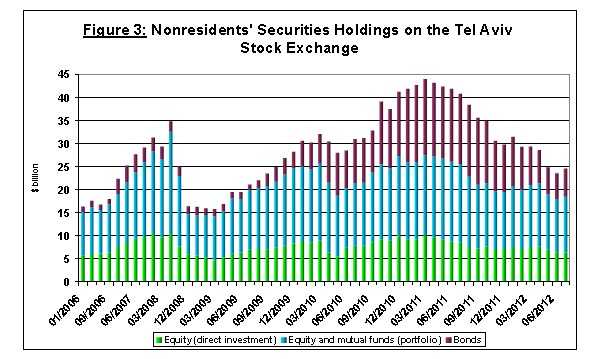· The value of Israeli residents' assets abroad declined by about $4.8 billion (1.8 percent) in the second quarter of 2012, to $260 billion. The increase was due mainly to price decreases on international capital markets (some 4 percent).
· The balance of liabilities to abroad declined by about $12.6 billion (5.5 percent) during the second quarter of 2012, and reached about $217 billion at the end of June. The decrease was due mainly to the large price declines on the Tel Aviv Stock Exchange (some 8.7 percent), but also to the continued sales of holdings of makam and government bonds by foreign residents.
· As a result of the more rapid decline in liabilities to abroad, the rapid increase in surplus assets over liabilities vis-à-vis abroad continued during this period (some $7.7 billion, 22.4 percent), reaching $42 billion at the end of June.
· The surplus of assets over liabilities vis-à-vis abroad in debt instruments alone continued to increase in the second quarter of 2012, by about $1.1 billion (1.9 percent), and reached about $60 billion at the end of June (a negative net external debt).
· The continued decline in Israel's gross debt to abroad since mid-2011 contributed to a decline of some 5 percentage points in the gross foreign debt to GDP ratio, and reached 41.6 percent at the end of June.

Israel's net assets abroad (the surplus of assets over liabilities) increased by about $7.7 billion (22.4%) in the second quarter of 2012, and was around $42 billion at the end of June. The increase in surplus assets in the portfolio derives from a decline in the value of liability balances due to price declines in the Israeli market and the sale of makam and government bonds. These were partially offset by price decreases on foreign markets and withdrawals of bank deposits abroad by local banks and the public, which reduced the value of the assets portfolio abroad.
It should be noted that since mid-2011, there has been a noticeable increase in the rate of growth of Israel's surplus assets over liabilities vis-à-vis abroad ($18 billion), mainly as a result of the continued decline in Israel's balance of liabilities to foreign residents – the sale of government bonds and makam in parallel to the decline in value of Israeli share portfolios in the local market (Figure 1).

The balance of Israel's assets abroad declined in the second quarter of 2012 by about $4.8 billion (1.8%), to reach $260 billion at the end of June.
The value of residents' stock portfolios abroad declined by about $1.7 billion (4.2%). A decline of $2.2 billion derived from price decreases on markets abroad was partially offset by net investments of some $570 million.
There were net investments in tradable bonds abroad of about $0.6 billion (2.3%), which were offset by price decreases and foreign exchange differentials.
In addition, in other investments, there were net withdrawals by the public from deposits with foreign banks abroad, of about $1.5 billion (12.6%). The decline in foreign currency balances of some $1.9 billion (2.4%) also contributed to the decline in the value of assets.
In contrast, the net flow of direct investments abroad by Israeli residents reached $0.9 billion (1.2%), following a similar amount in the first quarter of the year.
In the composition of residents' securities portfolio abroad, in the second quarter of 2012 there was a 1.1 percent increase in the direct investment component, with a decline in deposits and financial investments.
At the end of June 2012, direct investments constituted some 40% of the value of residents' securities portfolio abroad, with foreign bonds and other credit accounting for some 30%, shares for some 20% and deposits for some 10%.

The balance of Israel's liabilities to abroad declined during the second quarter of 2012 by about $12.6 billion (5.5%), and reached $217 billion at the end of June. The decrease in the balance of liabilities to abroad derived primarily from price declines of around $8.4 billion in the Israeli stock market (12.8%), and from net sales of about $2.9 billion (9.4%) in makam and government bonds by foreign residents.
The decline in the balance of liabilities to abroad was partially offset by the flow of net direct investments of $2.5 billion (3.9%). It should be noted that since mid-2011, Israel's gross liabilities have declined by some $26 billion – a combination of a decline in the value of Israeli shares held by foreign residents on the stock market, and the trend of selling makam and bonds during this period.
The value of nonresidents' financial portfolio on the Tel Aviv Stock Exchange declined in the second quarter of 2012 by around $5.8 billion (20%), and at the end of June was $23.6 billion. Nonresidents' bond holdings declined by $2.8 billion, and reached $5.6 billion; the value of their stock holdings declined by $1.9 billion to reach $11.5 billion, primarily the result of lower prices. (Figure 3).

The gross external debt
Israel's gross external debt fell by $5 billion (about 5 percent) in the second quarter of 2012, and at the end of June stood at about $95 billion. Most of the decline was the result of about $1.7 billion in foreign residents' sales of makam, and $940 million in nonresident investors' sales of government bonds.
The ratio of external debt to GDP at the end of June 2012 was 41.6 percent, a reduction of 0.5 percentage points from the ratio at the end of March 2012. The continued decline in Israel's debt to abroad has contributed, since the beginning of 2011, to a decline of some 5 percentage points in the gross external debt to GDP ratio.

The net external debt
The surplus of assets over liabilities abroad in debt instruments alone increased by about $1.1 billion (1.9%) in the second quarter of 2012, and reached $60 billion (i.e., a negative net foreign debt) at the end of June.
The balance of short-term debt assets was $112 billion at the end of June 2012, a coverage ratio of 2.5 of short term debt.
